

The Ghosts of Yesterday (1918) Norma Talmadge Film Corporation/Select Pictures Corporation. Produced by Joseph Schenck. Directed by Charles Miller, Scenario by Mildred Considine, Camera by Edward Wynard. Gowns by Lucile, Madame Frances. Cast: Norma Talmadge, Eugene O'Brien, Stuart Holmes, John Daly Murphy, Henry J. Hebert, Ida Darling, Blanche Douglas. 6 reels. Copies of reels 1-4 and a few dim feet of reel 6 are located at the Library of Congress (35 mm., some deterioration)
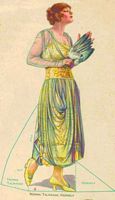 |
This paper doll shows Norma wearing one of her Lucile-designed gowns which appears in this film. |
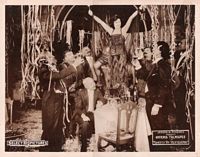 |
Some lobby cards courtesy of Derek Boothroyd | 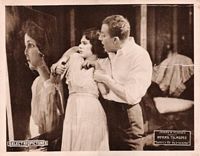 | 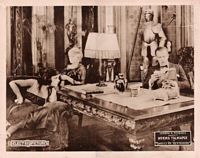 |
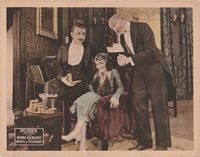 |
And a color one. |
"Ghosts of Yesterday"
Norma Talmadge Gives Superior Interpretation of Dual Role in Engrossing Photoplay Made from Stage Drama by Rupert Hughes--On Select Program
A stage drama written by Rupert Hughes for Mrs. Leslie Carter and called "Two Women" has been made into a photoplay by Mildred Consadine and produced by Joseph M. Schenck under the title of "Ghosts of Yesterday," with Norma Talmadge in the dual role of Ruth Grahame and Jeanne La Fleur. The screen version is in six parts, was directed by Charles Miller, and is on the Select Pictures program. The work may be best described as a modern "Camille."
Certain persons will find fault with the moral character of the heroine, and also condemn the hero for permitting a woman of doubtful character to take the place in his heart once occupied by his dead wife; but the dramatic value of the Hughes story cannot be denied. Those who sympathize with the highly wrought atmosphere of the Dumas play and regard the loves of Armand and his "lady with a past" as romance of the first rank, will find "Ghosts of Yesterday" greatly to their liking. They will be largely influenced in their decision by the lucid and engrossing telling of the drama, and the adroit manner of its presentation by Norma Talmadge, her supporting company, and Director Miller.
New York City is the locale of the opening scenes of the play. Howard Marston, who has thrown away a fortune in riotous living, is prevented from committing suicide by Ruth Grahame, a girl in humble circumstances. Marston learns to love his good angel and makes her his wife. He has studied painting, and manages to earn a modest living as an artist in a commercial establishment. Ruth, always frail, falls ill while her husband is painting her portrait, and dies just as Marston learns that an invention of his has again made him rich. The death of his wife leaves him inconsolable, and he goes to Paris to live. Marston is still in a morbid state of mind when he is taken to a cabaret by a friend and meets Jeanne LaFleur, its principal singer.
Jeanne is the typical woman of her class, unmoral and avaricious, but bears a remarkable likeness to Marston's dead wife. The man is beset with a strong desire to use Jeanne as his model and complete the portrait of Ruth. He persuades the French girl to agree, and has her become a member of his household while the work is being performed. The expected happens--the two fall in love with each other. Realizing his disloyalty to Ruth's memory, Marston tells Jeanne that he loves her only for her resemblance to his wife. In a fit of rage Jeanne picks up a knife and slashes the portrait to ribbons. She then returns to her old haunts and tries to forget Marston.
Hearing that the girl is at the home of Count Pascal, an old protector, the American, who finds that he loves Jeanne for herself alone, hurries to the place and saves her from the ardent Frenchman. During a struggle in the dark between the two men, Marston is slashed across the face by the Count, and loses his eyesight. Jeanne helps to nurse the stricken man. When she finds out that he may always be blind and that he loves her for herself she is overjoyed at the thought of becoming his companion for life. All of this is set forth on screen, with intimate views of "the gay life" of Paris and correct reproductions of the several grades of existence touched on in the photoplay.
In the dual role of Ruth and Jeanne the star is given an interesting opportunity to show her versatility, and gratifies her admirers by making the most of every phase of character presented by the two women. As Ruth she has the requisite sweetness and simplicity, and as Jeanne her impersonation of a woman of the Parisian underworld is illumined by all the exaggerated charm, tricks of manner, and want of right feeling that belong to the cabaret singing woman type. Her differentiation of the moral nature of the two women is always clear and convincing. Norma Talmadge has never appeared to better advantage in any drama intended for the screen.
Eugene O'Brien as Marston could hardly be improved upon. He succeeds in throwing just the air of romantic ardor about the character that would come nearest to excusing Marston's infatuation for Jeanne. Stuart Holmes is the embodiment of a cynical, well bred, and dissolute Frenchman, and John Daly Murphy is equally lifelike as an aged roue. Henry J. Hebert as Roger Sterns, Ida Darling as Mrs. Whitaker, and Blanche Douglas as Marie Calleaux are valuable members of the cast. The extras used in the cabaret scenes have been selected with excellent judgement.
Original comments after viewing on a Steenbeck at the Library of Congress, probably around 1999.
An interesting film, though in the only existing print the last two reels are missing (there is a very brief, very dim clip from the fight scene from probably reel 6). This is another double role for Talmadge. Her first character, the sweet wife, is killed off quickly, to make way for the notorious cabaret singer who looks exactly like his her. She emerges during the floor show in a giant champagne bottle, which in close-up looks like a coffin lined with roses. This is a rare "bad girl" part for Talmadge, and she enters into it with perhaps excessive enthusiasm, jumping about and waving her arms in a hyperactive frenzy. She is, however, very entertaining and often funny in the part, and one is quite disappointed when the print ends suddenly just as the plot begins to thicken.
Print viewed: 35mm. of reels 1-4 at the Library of Congress
Updated viewing comments after viewing the restored print at Pordenone, 2022
Good news on this one. It appears that reel 6 has been recovered, as there is much more footage that follows the brief fight scene noted above. Reel 5, including the slashing of the picture, is still lost, but has been bridged by titles, and stills from the collection of Derek Boothroyd, are posted above. Turned out this website got put to good use! Thanks to the whole retoration team!
Last revised, Decembr 7, 2022